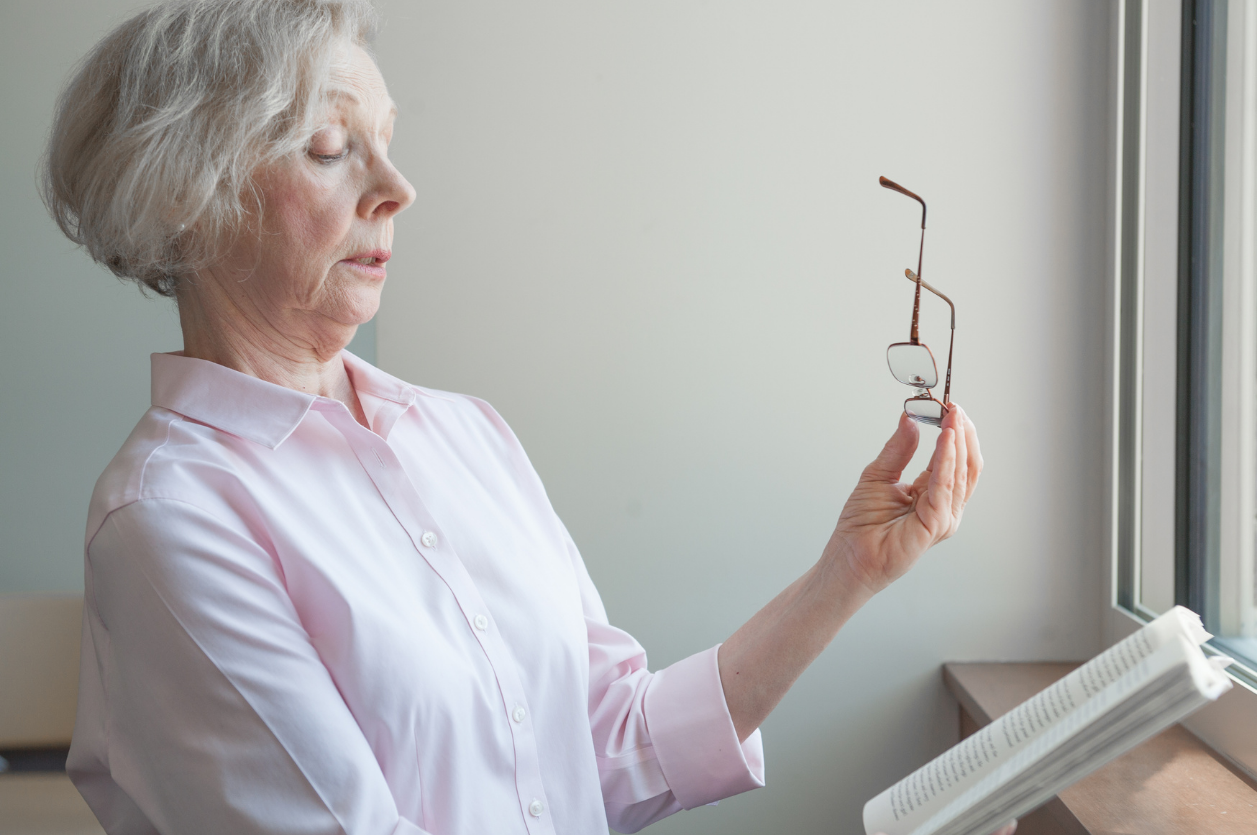Eight Potential Causes of Loss of Vision
Vision loss is a major issue for Americans across the country. According to the Centers for Disease Control (CDC), around 12 million Americans age 40 and older have some kind of vision impairment:
- Approximately 1 million Americans are blind
- Around 3 million Americans have some kind of vision loss after correction
- Some 8 million Americans have vision loss or impairment due to uncorrected errors
 What does vision loss entail? Vision loss, also called low vision, includes different degrees of sight loss, from blind spots, poor night vision, and problems with glare to an almost complete loss of sight. The Cleveland Clinic refers to the loss of sight that cannot be corrected with prescription eyeglasses, corrective contact lenses, or surgery. Since there is still some sight, which can sometimes be corrected to an extent, low vision or vision loss does not qualify as complete blindness.
What does vision loss entail? Vision loss, also called low vision, includes different degrees of sight loss, from blind spots, poor night vision, and problems with glare to an almost complete loss of sight. The Cleveland Clinic refers to the loss of sight that cannot be corrected with prescription eyeglasses, corrective contact lenses, or surgery. Since there is still some sight, which can sometimes be corrected to an extent, low vision or vision loss does not qualify as complete blindness.
The Industries for the Blind and Visually Impaired puts low vision into two categories:
- Being partially sighted refers to when a person has some vision, in one or both eyes. Someone who qualifies as being partially sighted has a visual acuity between 20/70 and 20/200, which does not improve with the use of corrective contact lenses or glasses.
- Someone who is legally blind has corrective vision that’s no better than 20/200, even with the use of corrective lenses in their best-seeing eye.
Eye diseases or disorders can cause visual impairment. Let’s explore what can cause low vision.
The American Optometric Association (AOA) lists the following as the leading causes of vision loss:
1. Macular degeneration
Macular degeneration is the leading cause of vision loss. It affects the central-most part of the retina, the light-sensitive lining at the back of the eye that focuses images and sends information to the brain. The macula, which is the area on the retina responsible for sharp central vision, degrades in one of two ways, which causes blurred vision. This can mean difficulty reading and, for some, a blurry or blind spot in the central area of vision. For some, it can also mean straight lines appear wavy or wiggly.
Typically, macular degeneration is most common in older adults, beginning in their 50s and increasing in number and severity as people age. The Mayo Clinic lists the following as risk factors for macular degeneration:
- A family history of macular degeneration
- Advanced age
- A history of smoking
- Obesity
- Cardiovascular disease
2. Cataracts
The National Eye Institute defines a cataract as, “A cloudy area in the lens of your eye.” This lens is right behind the iris, or the colored part of the eye, and its function is to focus light on the retina, which then sends the image to the brain via the optic nerve. But when cataracts develop, this light is scattered, which keeps the lens from focusing properly and resulting in a general loss of vision. The lenses in our eyes are made mostly from proteins and water. When these lenses experience changes, clouding and cataracts develop.
Cataracts can be removed through a safe surgery that corrects the issues that cataracts cause. There are no initial symptoms of cataracts, but as they progress, cataracts can show the following warning signs:
- Blurred vision
- Hazy images
- Seeing less color
- Trouble reading or doing everyday activities
3. Glaucoma
Glaucoma is an eye disease that damages the optic nerve, causing permanent vision loss. The optic nerve is responsible for sending visual information from the eyes to the brain. Usually, this is the result of exceptionally high pressure inside the eye. This pressure erodes the optic nerve and can lead to vision loss or blindness. When caught early enough, you can stop glaucoma from progressing.
There aren’t many early symptoms of glaucoma, but Healthline lists the following as the first signs of glaucoma damage:
- Changes or defects in peripheral vision
- Severe eye pain
- Nausea and vomiting
- Redness in the eye
- Sudden disturbances in your vision
- Seeing colored rings around light
- Blurred vision that comes on quickly
4. Diabetic retinopathy
Diabetic retinopathy is a complication of both Type 1 and Type 2 Diabetes that can affect the eyes. The Mayo Clinic states that damage to the blood vessels of the light-sensitive retina is caused by changing, uncontrolled blood sugar levels. The longer a patient’s blood sugar levels go unchecked, the more likely they are to develop diabetic retinopathy.
According to the AOA, diabetes can cause the blood vessels that flow into the retina to develop leaking “branches,” or extraneous vessels, which can interfere with vision. Laser and surgical treatments can slow the progression of diabetic retinopathy, but the most important thing people with diabetes can do is to keep their blood sugar regulated.
5. Retinitis pigmentosa
Retinitis pigmentosa refers to a group of genetic disorders that breakdown the cells in the retina, and is a very rare condition. Since it breaks down the light-sensitive tissue of the retina, many patients with retinitis pigmentosa experience difficulty seeing at night, and a loss of peripheral vision.
Retinitis pigmentosa, or RP, is very rare, with about 1 in 4,000 Americans affected by the disorder. RP affects any one of more than 50 genes in a person’s DNA, which carry instructions for making proteins that the retina needs, which damages the photoreceptors. How does RP affect these proteins?
- The gene cannot make the necessary protein
- The protein that’s created is toxic to the cell
- The protein doesn’t function the way it should
6. Amblyopia
Amblyopia, sometimes called lazy eye, is a kind of poor vision that happens in one eye. It happens because there is a breakdown in how the brain and the eye work, which means the brain can’t recognize sight in the affected eye. As the condition progresses, the brain relies more and more on the strong eye, while the affected eye worsens. The National Eye Institute points out that while amblyopia is called “lazy eye,” this doesn’t mean that the patient is lazy. It just means that they cannot control their weaker, “lazy” eye.
Amblyopia begins in childhood and is a common cause of vision loss in children. As many as 3 out of 100 kids have amblyopia, but early treatment can prevent long-term vision issues.
7. Detached retina
The AOA states that a detached retina happens when the retina separates from the underlying layer of blood vessels that provide oxygen and nutrients to the retina. This can lead to total vision impairment in the affected eye.
The longer that retinal detachment goes without treatment, the greater the chance is that the patient will lose vision in their affected eye. If you experience any of the following warning signs of a retinal detachment, it’s important to see your doctor right away:
- The sudden appearance of “floaters”
- Flashes in the line of sight
- Reduced vision
Oftentimes, a detached retina can be reattached surgically if it’s caught early, and vision can be fully or partially restored with treatment.
8. Traumatic brain injury
When someone incurs a head injury, brain damage, or a stroke, it can cause vision loss. In these cases, patients experience reduced visual acuity or a reduced visual field. They may also experience the following symptoms:
- Contrast sensitivity
- Blurred vision
- Eye misalignment
- Poor depth perception
- Sensitivity to glare
- Confusion involving visual tasks
- Challenges when reading
- Double vision
- Headaches
- Dizziness
- Atypical posture
- Balance problems
People with a traumatic brain injury can suffer vision loss because 40 to 50 percent of the brain is involved in vision. If a person’s brain is damaged, there’s a high chance that their vision will also be affected somehow.
The Most Common Types of Low Vision
Any time a patient experiences a loss of vision, it’s imperative that they see their optometrist right away to discover the cause. The AOA states that common types of low vision include:
- Central vision loss like a blur or blind spot, while the peripheral vision remains. It can be hard to read or recognize faces or identify far-away details.
- Peripheral (side) vision loss means that patients cannot see anything on one or both sides, or things directly above or below eye level, which can affect mobility. This is sometimes referred to as "tunnel vision."
- Blurred vision means both near and far vision is out of focus, even with correction with prescription eyeglasses or contacts.
- Reduced contrast sensitivity means there is a loss of vision quality. This can feel like a general haze like there’s a filmy quality or cloudiness.
- Sensitivity to glare can overwhelm the visual system creating a faded image or a glare. Those with acute light sensitivity might have pain or discomfort from normal light levels.
- Night blindness makes it difficult, or even impossible to see at night or in dimly lit spaces.
Detect Problems Early With an Exam From Vision Source Plano
Regular eye exams are important for general eye health, but they can also serve to detect and prevent vision loss.
At Vision Source Plano, our individualized approach to optometry makes Dr. Malone and staff the eye and vision care providers of choice in the Plano area. We offer the following services:
- Complete eye exams
- Contact lenses and glasses
- Glaucoma testing
- Pre/post-operative care
- Dry eye treatment and diagnosis
We also work with other practitioners in the control and treatment of diabetic eye disease.
We offer financing options and work with your vision insurance provider to ensure the best in eye health and vision care.
For a complete list of services, visit our services page or call our Plano office at (972) 612-2099.
At Vision Source Plano, we are dedicated to providing high-quality optometry services in a comfortable environment.
Call us at (972) 612-2099, or schedule an appointment online today.
Disclaimer: The content on this blog is not intended to be a substitute for professional medical advice, diagnosis, or treatment. Always seek the advice of qualified health providers with questions you may have regarding medical conditions.








